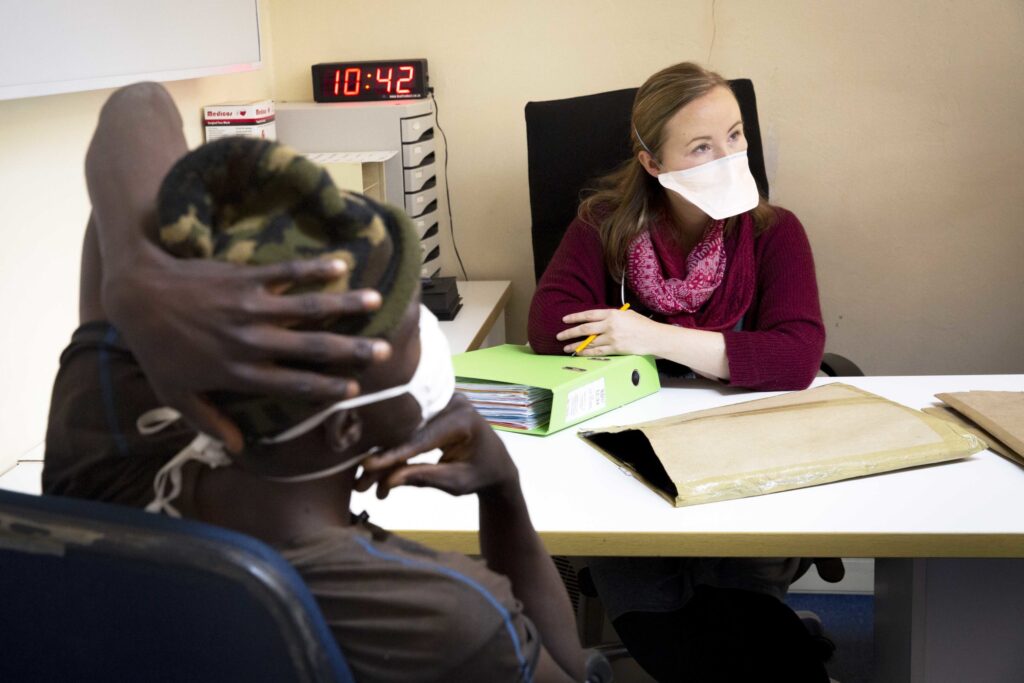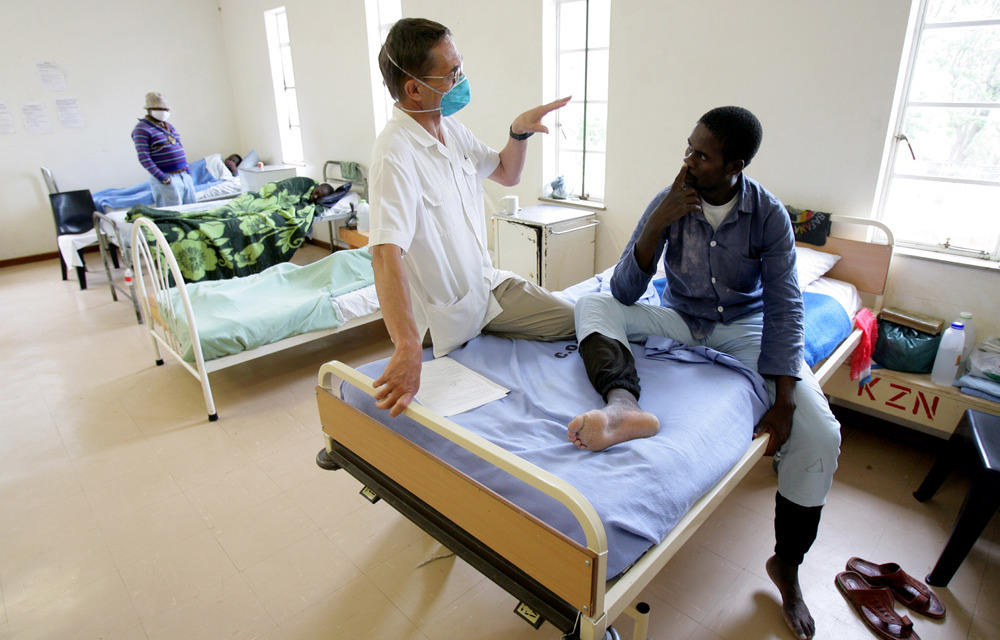- More than half of people in South Africa who are already sick with tuberculosis (TB) may not realise it because they don’t have any of the symptoms often linked with the disease, such as coughing and weight loss.
- Researchers don’t yet know to what extent people with asymptomatic TB spread the disease. It’s also unclear whether people with symptomless disease will necessarily fall ill.
- South Africa’s health system has switched gears to catch more cases of asymptomatic TB. For example, from 2023 to 2028, a third of the country’s R25-billion TB budget will go to finding more people who are sick with the disease (whether they’ve got symptoms or not).
Our idea of what a tuberculosis (TB) patient normally looks like probably needs an update, says Emily Wong, an infectious diseases researcher at the Africa Health Research Institute in Durban.
Until recently, scientists have said that you’ll know you have active TB if you’re losing weight, coughing all the time, or experiencing fever or night sweats. Active TB is the term health workers use to describe a TB infection that can no longer be contained by your immune system because the bacteria are replicating in your body too fast.
This classic picture is changing. More than half of people who have TB might not know they’re ill (in other words, they’re asymptomatic), according to the first study to determine how widespread the disease really is in South Africa.
This evidence that there are so many asymptomatic cases in South Africa led to a change in the way that government health facilities will manage the disease from this year onwards.
The country’s latest TB action plan (which runs from 2023 to 2028) has, for example, switched gear to find more such symptomless TB cases by beefing up methods for diagnosing cases, such as digital chest X-rays, at state facilities.
Digital chest X-rays are better at picking up traces of TB disease than the GeneXpert test, which analyses people’s sputum, found 2020 research published in the International Journal of Tuberculosis and Lung Disease.
Although the machines are pricey, a study across 64 prisons in South Africa found that the cost might be worth it in high-risk cases because screening with digital chest X-rays can catch symptomless cases, which would have gone unnoticed otherwise.
About a third (32%) of the R25-billion South Africa has budgeted to test, treat and prevent TB from now until 2028 will be spent on finding people with TB, the country’s strategy document for dealing with HIV, TB and sexually transmitted infections estimates.
The health department also says that it will publish treatment guidelines for asymptomatic TB.
But many questions about asymptomatic TB remain unanswered.
In March, we interviewed Wong for an episode of The Bhekisisa Podcast to find out what we do know about this category of TB, and what we don’t.
Here’s a summary of what she said.
What are the characteristics of the average TB patient?
It’s hard to say anymore, Wong explains, because in the last couple of years, researchers realised that the conventional image of a person with TB is inaccurate.
The public health and research community used to say that someone who has active TB feels really ill. This person is often coughing a lot, losing weight or experiencing fevers or night sweats.
But new research from South Africa is showing that more than half (58%) of people in a large national survey in whose sputum samples the TB germ was found, didn’t experience any of the symptoms health workers are typically taught to look for when diagnosing TB.
They may even say that they feel well and that they’ve been continuing with their daily lives as usual, completely unaware that their bodies are fighting a TB infection.
This category of TB is called subclinical, or asymptomatic TB.
What is the difference between latent, subclinical and full-blown TB?
Latent TB is when someone has been infected by the germ that causes TB (Mycobacterium tuberculosis), but it’s hiding somewhere in the body in a quiet state and not spreading because the person’s immune system is containing the infection.
The health department doesn’t test people in South Africa for latent TB. But studies have shown that between 34% and 88% of participants in surveys conducted in townships in Cape Town and Johannesburg were infected with the germ but did not develop illness.
Subclinical (asymptomatic) TB is different.
Researchers think that, at this stage the TB bacteria are replicating and the immune system is putting up a fight to beat the bug. This battle causes some damage, but it’s not severe enough yet to make the person lose weight or cough all the time or cause enough discomfort to result in their going to a clinic to get help.
So, you may be in a very early state of TB disease but not be aware of it.
When someone has full-blown TB disease (active TB), the fight between their body’s immune system and the bug is ramped up to the point where they feel ill and have the symptoms health workers typically look for when they suspect a TB infection.
Will someone with subclinical TB eventually develop symptoms of full-blown TB?
Researchers are very interested in this question, but there’s no clear answer to it yet.
It is likely that some people who have subclinical TB will develop full-blown TB, especially if they don’t find out about it while they’re still in the early stage of the disease.
But it’s hard to know for sure in how many cases this will happen, because people are unlikely to get themselves tested for TB if they’re not feeling ill. What further complicates the answer is that when a doctor does find out that a patient has asymptomatic TB, they’ll prescribe treatment straight away. It would be unethical for doctors to delay treating somebody for TB disease so that they could see whether that person will eventually experience symptoms. That also means, for the most part, researchers don’t find out what would have happened if there were no treatment.
Do people with asymptomatic TB also spread the bacteria to others?
This is another question to which researchers don’t yet have the complete answer.
Scientists think that if someone has the TB organism in their sputum, it’s probable that they could transmit that organism to someone else.
Researchers have always thought that TB germs spread mostly through coughs. But with asymptomatic TB, people aren’t coughing.
However, there’s new evidence from a study in Cape Town, published in the American Journal of Respiratory Critical Care Medicine in 2022, which shows that TB germs in respiratory droplets released from simple, deep breathing can be just as infectious as those in coughs.
This new information would imply that people with asymptomatic TB could indeed be passing the bug on to others.
How does South Africa’s health system handle asymptomatic TB?
Until recently, people were not tested for asymptomatic TB in South Africa. But new guidelines, published by the national health department in February, now recommend that people who may have a high risk of getting TB (such as people with HIV, health workers and children, or who live in a household with somebody on TB treatment), should get chest X-rays and have their sputum tested during their regular clinic visits.
This project has already started around the country, so it’s possible that people could be diagnosed with asymptomatic TB through these efforts.
When people test positive for TB (whether they have symptoms or not), South Africa’s guidelines recommend that they take a six-month course of antibiotics to clear up the infection.
Wong says that researchers want to find out whether people with asymptomatic TB might have a milder form of TB. If that’s the case, then perhaps they could take a shorter course of TB treatment to clear the infection. That way, they won’t have to deal with the side effects (which can include nausea or skin rashes) for so long, and can get back to their daily lives quicker.
No studies have been conducted to test this idea yet.
What should people do if they’re worried about getting infected with TB?
South Africa’s guidelines say that anyone who’s been exposed to the bug can get a course of TB preventive treatment that will stop them from falling ill as long as they test negative for active TB first.
That includes people who have been in contact with somebody on TB treatment in the last year, whether that person lives with them, or is a teacher, colleague, family member or friend.
How does TB preventive medicine work?
In South Africa, the preventive treatment against TB available in most public sector clinics (and given to people with HIV) is called isoniazid. This antibiotic is taken as a pill daily for a year.
In people who are infected with both HIV and TB, as in South Africa, the medicine stops people from developing full-blown TB disease in about 60% of cases.
There are also shorter treatment options, such as getting a weekly dose of two antibiotics, isoniazid and rifapentine, for three months. This treatment is commonly called 3HP, but it’s not widely available at state clinics yet.
How do people react to research findings about asymptomatic TB?
“A while back I presented some of my research to colleagues here [at the Africa Health Research Institute]. The data showed that 10% of people with asymptomatic TB had a drug-resistant version of the bug (which means one of the most effective medicines such as isoniazid no longer works).
“Among them were some people who had an early version of extensively drug-resistant TB (XDR-TB), but also had no symptoms. XDR-TB can’t be treated with any of the antibiotics normally used to treat TB (namely isoniazid and rifampin), nor any of the next-best type of drugs called fluoroquinolones, or another class of antibiotics, such as bedaquiline or linezolid.
“People started looking around the room, visibly worried, as if they were wondering whether people around them might have asymptomatic TB.”
Wong says she thinks it’s researchers’ and the health department’s responsibility to figure out how asymptomatic TB really works — and get the TB epidemic under control. That means, she says, setting up a sensible plan to screen, test and treat people for TB, and to give those who have a high risk of getting infected but test negative preventive therapy.
What should we do to prevent the stigma around TB spreading?
Wong compares it to how people thought about HIV infection long ago. Before antiretroviral drugs were available to treat HIV, people automatically thought that simply being infected with the virus was the same as having severe Aids — and imminently dying.
But then, as people got tested earlier, they could get treatment long before they got very ill. More effective treatment also became available, as did preventive drugs, which meant that people could carry on with their lives as normal and stay healthy for long.
“All of this has helped us to change our idea of what HIV is, and helped us to fight the stigma around it,” says Wong.
“If we end up changing our image of TB from someone who’s very sick to an earlier image of what it means to have TB [but without any symptoms], we could decrease stigma. But this is a process. It doesn’t happen overnight.”
Joan van Dyk was a health journalist, senior health journalist and news editor at Bhekisisa between 2017 and 2023.







